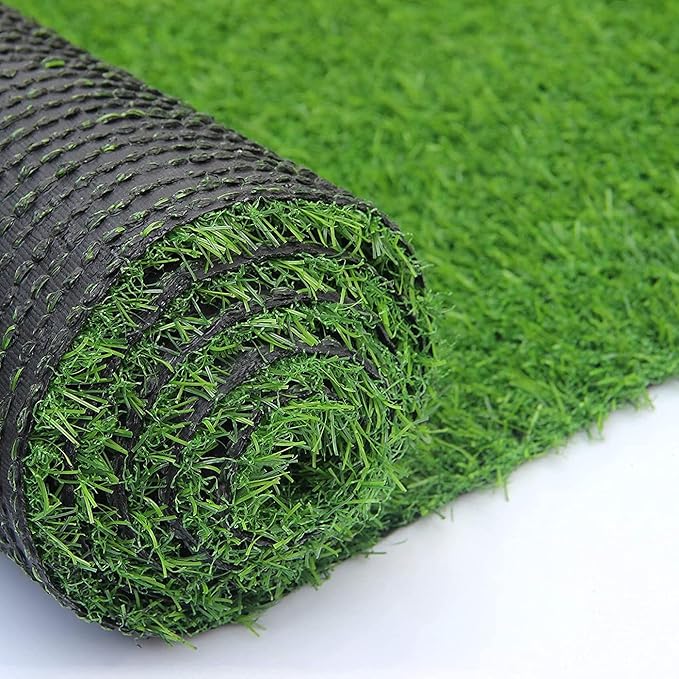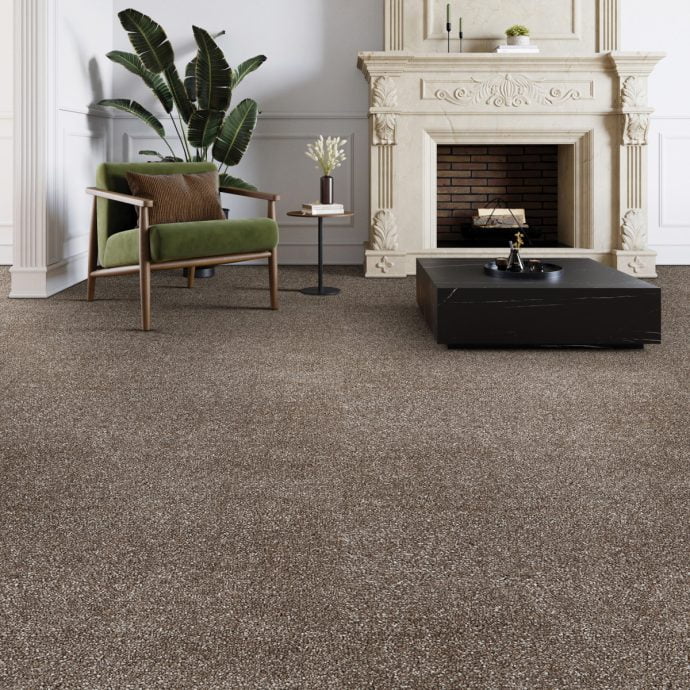In recent years, the interior design world has witnessed a resurgence of interest in natural materials and sustainable decor options. Among these eco-conscious choices, jute carpets have emerged as a timeless and versatile flooring solution that is making a notable comeback in interior design circles.
Jute, a natural fiber derived from the jute plant, has been used for centuries to create textiles, rugs, and carpets. With its inherent durability, earthy texture, and eco-friendly properties, jute offers a compelling alternative to synthetic and mass-produced flooring materials.
In this article, we’ll explore the reasons behind the renewed popularity of jute carpets in interior design. From their organic appeal and tactile charm to their environmental benefits and design versatility, jute carpets have captured the attention of designers, homeowners, and eco-conscious consumers alike.
Join us as we delve into the captivating world of jute carpets, discovering why they have become a coveted choice for creating warm, inviting, and sustainable living spaces.
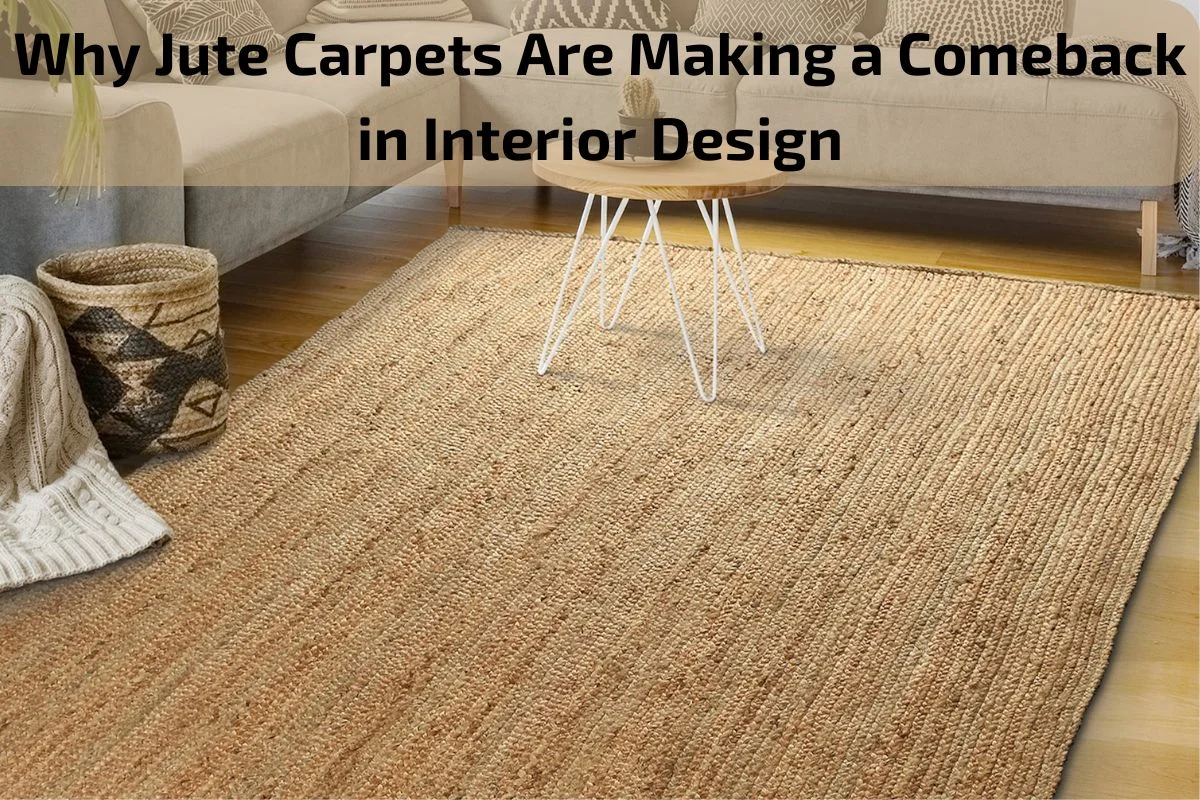
Brief Overview of Jute Carpets:
Jute carpets are natural floor coverings crafted from the fibers of the jute plant, a versatile and sustainable crop grown primarily in the Indian subcontinent. These carpets embody the essence of eco-friendliness and rustic charm, making them increasingly popular choices in modern interior design.
Jute, known for its robustness and durability, lends itself well to carpet weaving, offering a unique blend of strength and softness. Jute carpets exude a distinct earthy texture and natural warmth, adding a touch of understated elegance to any room.
Renowned for their biodegradability and environmentally friendly nature, jute carpets stand as symbols of sustainability in the realm of interior decor. They serve as testament to the growing preference for eco-conscious design choices that prioritize both style and environmental responsibility.
In the following sections, we’ll delve deeper into the allure and practicality of jute carpets, exploring their myriad benefits, applications, and considerations for those seeking to incorporate them into their living spaces.
The Rise of Jute Carpets in Interior Design
The emergence of jute carpets as a prominent element in interior design reflects a broader trend towards sustainability, natural materials, and timeless aesthetics. This section explores the factors contributing to the growing popularity of jute carpets within the realm of interior design.
Environmental Consciousness: In an era marked by increasing environmental awareness, consumers are seeking eco-friendly alternatives to conventional home decor materials. Jute carpets, made from natural fibers derived from the jute plant, resonate with individuals committed to reducing their ecological footprint.
Rustic Elegance: Jute carpets exude a distinctive rustic charm that adds character and warmth to any space. Their natural texture and earthy tones complement a wide range of design styles, from contemporary to farmhouse chic, making them versatile choices for both residential and commercial interiors.
Texture and Depth: Jute carpets offer a tactile experience that enhances the sensory appeal of interior spaces. The fibers’ inherent coarseness creates visual interest and depth, adding dimension to floors and enriching the overall design scheme.
Versatility in Design: One of the most appealing aspects of jute carpets is their adaptability to various design aesthetics. Whether used as standalone rugs or layered with other floor coverings, jute carpets effortlessly integrate into diverse decorating styles, from bohemian and coastal to minimalist and eclectic.
Warmth and Comfort: Beyond their visual appeal, jute carpets imbue spaces with a sense of coziness and comfort. Their soft yet resilient texture provides a welcoming surface for bare feet, enhancing the overall ambiance of living areas, bedrooms, and lounges.
Natural Light and Airiness: Jute carpets have the unique ability to reflect natural light and imbue rooms with a sense of airiness and openness. Their neutral hues and light-reflective qualities create a harmonious balance of light and shadow, elevating the atmosphere of any interior setting.
Longevity and Durability: Despite their natural origins, jute carpets boast impressive durability and longevity. When properly maintained, they can withstand daily wear and tear, making them practical choices for high-traffic areas such as living rooms, hallways, and entryways.
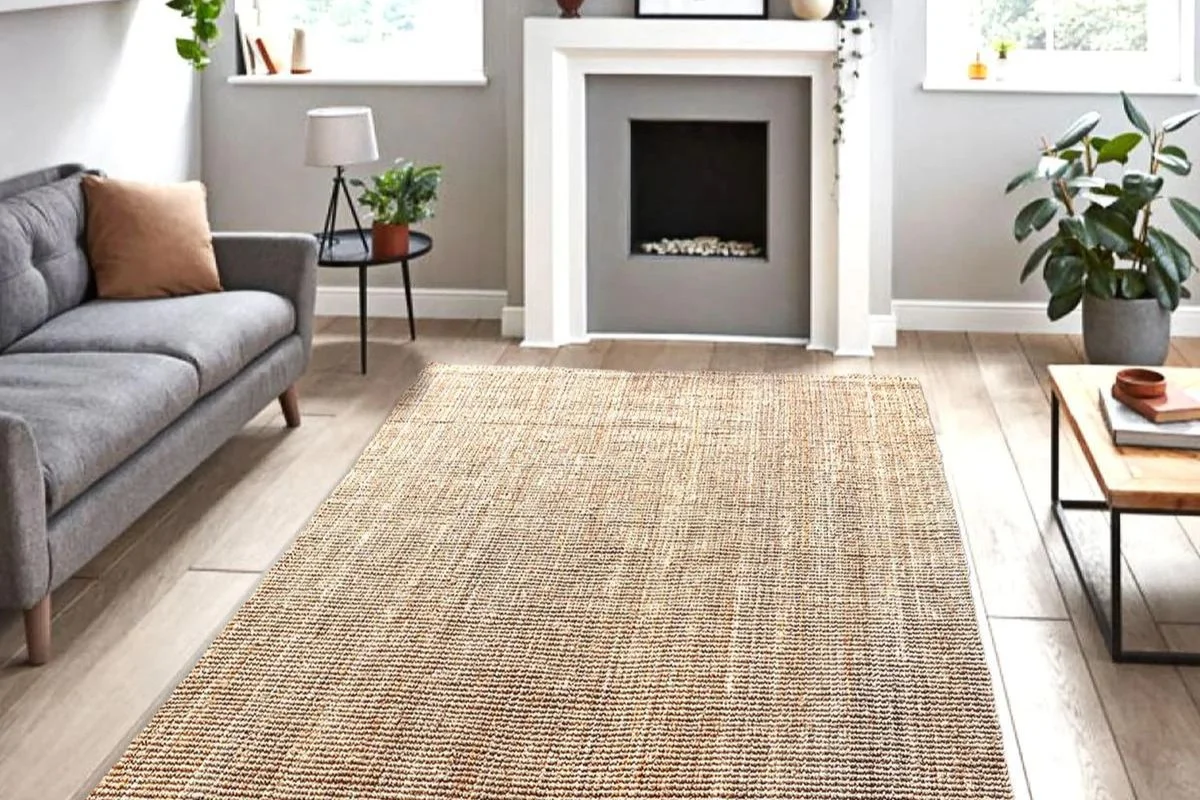
Advantages and Disadvantage of Jute Carpets
Jute carpets, like any other flooring option, come with a set of advantages and disadvantages. Understanding these factors can help homeowners and designers make informed decisions when considering jute carpets for their spaces.
Advantages:
Environmentally Friendly: Jute carpets are made from natural fibers derived from the jute plant, making them biodegradable and eco-friendly. They contribute to sustainable living practices by reducing reliance on synthetic materials and minimizing environmental impact.
Natural Aesthetics: Jute carpets exude a rustic charm and organic appeal that adds character to interior spaces. Their earthy texture and neutral tones create a warm and inviting atmosphere, enhancing the visual appeal of any room.
Softness and Comfort: Despite their coarse appearance, jute carpets offer a soft and comfortable surface underfoot. They provide a cozy environment for relaxation and barefoot walking, making them ideal for bedrooms, living rooms, and lounging areas.
Versatility in Design: Jute carpets complement a variety of design styles, from traditional to contemporary. They can be used as standalone rugs or layered with other floor coverings to create visual interest and depth in interior spaces.
Breathability: Jute fibers are naturally breathable, allowing air to circulate through the carpet and prevent moisture buildup. This feature helps maintain a healthy indoor environment by reducing the risk of mold and mildew growth.
Disadvantages:
Susceptibility to Moisture: Jute carpets are prone to damage from moisture and humidity. Excessive exposure to water can cause the fibers to swell, leading to warping, mold, and decay. As a result, jute carpets may not be suitable for areas with high humidity or frequent spills.
Staining and Soiling: Jute carpets are more susceptible to staining and soiling compared to synthetic alternatives. Spills should be promptly cleaned to prevent permanent discoloration and damage to the fibers. Regular maintenance and stain-resistant treatments can help mitigate this issue.
Limited Durability: While jute carpets offer softness and comfort, they may lack the durability and resilience of synthetic carpets. They are more prone to wear and tear, particularly in high-traffic areas, and may require replacement sooner than other flooring options.
Pricing: Jute carpets tend to be more expensive than synthetic alternatives due to their natural origins and manufacturing processes. The higher cost may deter some homeowners from choosing jute carpets as their primary flooring option.
Allergen Sensitivity: Individuals with allergies or sensitivities may react to jute fibers, particularly if they are not properly cleaned and maintained. Dust and debris can accumulate in the carpet, triggering allergic reactions in sensitive individuals.
Aesthetic Appeal and Design Versatility
Jute carpets are celebrated for their natural beauty and versatile design. Their subtle golden tones and textured appearance add warmth, depth, and sophistication to any interior. Whether used in modern minimalist homes or traditional settings, jute carpets complement various décor styles effortlessly.
Designers appreciate jute’s organic look, which blends seamlessly with wood, stone, and neutral color palettes. The natural fibers create visual interest through their woven patterns, which can range from simple braided textures to intricate hand-knotted designs. The understated elegance of jute allows it to serve as both a statement piece and a complementary accent.
One of the key advantages of jute carpets is their adaptability. They pair well with other natural materials such as cotton, wool, or sisal, and they can be layered under patterned rugs for a stylish contrast. Jute’s neutral tone makes it an excellent backdrop for colorful furniture, artwork, or bold décor elements.
In addition to aesthetics, jute carpets create a calming and inviting ambiance. Their natural texture adds a tactile dimension that enhances comfort underfoot. As sustainability becomes a growing trend in interior design, jute carpets represent a perfect harmony of style and conscience, elevating interiors while respecting the planet.
Durability and Performance
While jute carpets are admired for their natural appeal, they also offer impressive durability when used appropriately. The fibers are strong and resilient, capable of withstanding moderate foot traffic in areas such as living rooms, bedrooms, and home offices. When maintained properly, jute carpets can retain their beauty and structure for many years.
However, jute is more delicate compared to synthetic or wool carpets and is not ideal for high-moisture environments. Excess humidity can cause the fibers to weaken or discolor. Therefore, it’s best to use jute carpets in dry, well-ventilated spaces.
Despite their natural softness, jute carpets hold their shape well and provide a firm yet comfortable surface. They are particularly valued for their acoustic and thermal insulation properties—reducing noise and maintaining comfortable temperatures indoors.
For added longevity, some manufacturers blend jute with other fibers like cotton or synthetic materials to enhance strength and stain resistance. Regular maintenance, including gentle vacuuming and immediate spot cleaning, can significantly extend their lifespan.
In essence, jute carpets offer a balanced combination of beauty, durability, and comfort, making them a practical choice for homeowners seeking natural elegance.
Maintenance and Cleaning Tips
Proper care ensures that jute carpets maintain their natural beauty and longevity. Regular vacuuming with a brush attachment helps remove dust and debris, preventing buildup in the fibers. Avoid using beater bars, as they may damage the delicate weave.
Spills should be addressed immediately. Blot the area with a clean, dry cloth—never rub, as this may push the liquid deeper into the fibers. Because jute is sensitive to moisture, it’s important to minimize water contact. For deeper cleaning, use a dry carpet shampoo or baking soda to absorb odors and dirt.
Humidity control is essential. Excessive moisture can cause mold or mildew growth, so jute carpets should not be used in damp areas. Using a dehumidifier or ensuring proper ventilation helps maintain fiber integrity.
Periodic professional cleaning with dry methods can also preserve the carpet’s texture and color. Adding a rug pad underneath not only enhances comfort but also improves air circulation and prevents slippage.
With consistent care and mindful cleaning, jute carpets can stay beautiful for years, providing a natural and cozy touch to any living space.
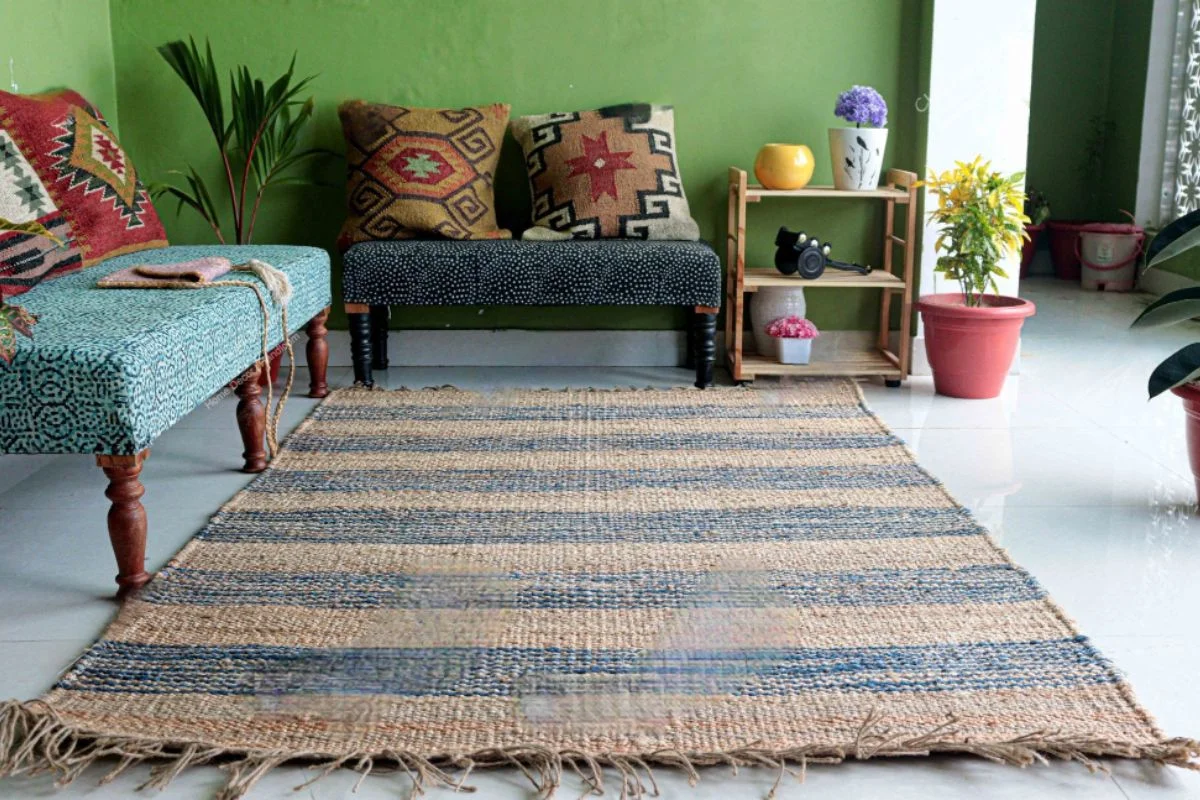
Maintenance Requirements: Cleaning and Care Tips for Jute Carpets
Proper maintenance is essential to preserve the beauty and longevity of jute carpets. Here are some cleaning and care tips to keep your jute carpets looking their best:
Regular Vacuuming: Use a vacuum cleaner with a brush attachment to remove dust, dirt, and debris from the surface of the jute carpet. Vacuum the carpet at least once a week, focusing on high-traffic areas and areas prone to spills.
Spot Cleaning: Promptly address spills and stains on the jute carpet to prevent them from setting and becoming permanent. Blot the affected area with a clean cloth or paper towel to absorb excess liquid. Avoid rubbing the stain, as this can spread it further. Use a mild detergent diluted in water to gently clean the stain, then blot with a damp cloth to rinse. Allow the area to air dry thoroughly.
Avoid Excessive Moisture: Jute carpets are sensitive to moisture and can be damaged by excessive water exposure. Avoid steam cleaning or wet shampooing jute carpets, as this can cause the fibers to swell and warp. Instead, opt for dry cleaning methods or spot cleaning with minimal moisture.
Rotate Furniture: To prevent uneven wear and indentation marks, regularly rotate furniture placed on top of the jute carpet. This helps distribute the weight evenly and minimizes the risk of permanent damage to the carpet fibers.
Use Rug Pads: Place rug pads underneath the jute carpet to provide additional cushioning and prevent slipping. Rug pads also help protect the underlying flooring surface and extend the lifespan of the jute carpet.
Avoid Direct Sunlight: Prolonged exposure to direct sunlight can cause fading and discoloration of jute carpets. Position furniture and area rugs strategically to shield the carpet from harsh sunlight. Consider using curtains or blinds to regulate sunlight exposure in the room.
Professional Cleaning: Periodically, consider professional cleaning services for deep cleaning and maintenance of your jute carpet. Professional cleaners have the expertise and equipment to effectively remove embedded dirt and stains without damaging the carpet fibers.
Regular Inspection: Routinely inspect the jute carpet for signs of wear, damage, or pest infestations. Address any issues promptly to prevent further deterioration and maintain the overall condition of the carpet.
Jute Carpets in Modern Interior Design
Modern interior design celebrates simplicity, functionality, and sustainability—qualities that perfectly align with jute carpets. Their natural tones and organic textures create a sense of calm and balance in contemporary homes. Designers often use jute carpets as grounding elements that complement minimalist spaces.
Jute carpets pair beautifully with neutral color palettes, natural woods, and modern furniture. They add warmth to sleek, modern interiors without overwhelming the space. In Scandinavian and Japandi designs, jute’s raw beauty enhances the “less is more” philosophy by introducing tactile contrast to clean lines.
They are also excellent for layering—a popular interior trend. Placing a patterned or colorful rug over a large jute carpet creates visual depth and character. Jute carpets also fit perfectly in eco-friendly and biophilic designs, connecting indoor spaces with nature.
Whether in city apartments or beach houses, jute carpets deliver an effortless charm that embodies modern sustainability. They prove that natural materials can be both chic and environmentally responsible.
Comparing Jute Carpets with Other Natural Fibers
When choosing natural fiber carpets, it’s important to compare jute with alternatives like sisal, seagrass, and coir. Each material offers unique characteristics and advantages.
Sisal carpets are firmer and more durable than jute, making them ideal for high-traffic areas. However, they are rougher underfoot. Jute, in contrast, is softer and more comfortable, suitable for cozy spaces like bedrooms or lounges.
Seagrass is highly water-resistant and works well in areas exposed to moisture. It has a shiny texture and natural greenish tint. Jute’s warm tones, on the other hand, create a softer and more inviting aesthetic.
Coir carpets, made from coconut husks, are coarse and durable but less refined. Jute provides a smoother, more elegant alternative for those who prioritize comfort and style.
While each natural fiber has its place, jute stands out for its softness, affordability, and eco-friendly nature. It’s the perfect choice for homeowners seeking sustainable luxury without sacrificing comfort.
The Role of Jute Carpets in Sustainable Living
Sustainability is more than a trend—it’s a necessity. Jute carpets embody this philosophy by promoting responsible consumption and environmental stewardship. Because they are made from renewable plant fibers, they have a minimal carbon footprint.
Jute carpets are free from synthetic chemicals, making them safe for indoor environments. Their production supports ethical trade practices and empowers rural artisans, particularly women in developing regions. By choosing jute, consumers directly contribute to fair labor practices and community development.
Moreover, jute carpets encourage mindful living. Their natural imperfections remind us of nature’s beauty, fostering appreciation for handcrafted goods. Unlike mass-produced synthetic flooring, each jute carpet tells a story of craftsmanship and sustainability.
For eco-conscious homeowners, jute carpets serve as a daily reminder that luxury and responsibility can coexist harmoniously.
Conclusion
In conclusion, jute carpets offer a blend of natural beauty, eco-friendliness, and timeless appeal that make them a standout choice in interior design. Throughout this article, we’ve explored the advantages and disadvantages of jute carpets, as well as essential maintenance tips to preserve their quality and longevity.
The most important frequently asked questions about Jute Carpets
Is jute carpet eco-friendly?
Absolutely—it’s one of the most sustainable carpet materials.
What does a jute carpet feel like?
It’s mainly grown in India and Bangladesh.
Can jute carpet be used outdoors?
No, it’s designed for indoor use only.
Is jute carpet durable?
It’s durable in low to medium-traffic areas but not ideal for heavy use.

